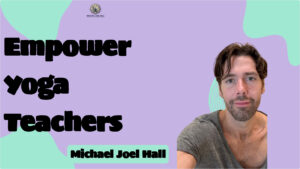Video: Overcome Burnout: Reclaim Your Energy with Ashtanga Yoga
Are you feeling overwhelmed and burnt out? Visit michaeljoelhall.com/coaching to book a session if you’d like to chat about your practice.

Are you feeling overwhelmed and burnt out? Visit michaeljoelhall.com/coaching to book a session if you’d like to chat about your practice.

In the United States, the debate over whether yoga teachers should be classified as employees or independent contractors is complex and fraught with challenges. The truth is, the role of a yoga teacher often aligns more closely with the responsibilities and characteristics of a contractor rather than an employee.

Caring for others is often considered a noble and virtuous responsibility, one that evokes feelings of compassion, duty, and love. However, the act of caring is not always straightforward. It is a complex burden that requires more than just emotional investment. For those who have taken on the role of caregivers, the emotional toll can be immense, and the line between caring for others and simply managing the logistics of caregiving often becomes blurred. The reality is that caring for someone isn’t the same as being good at it.

The Screen Actors Guild (SAG), now SAG-AFTRA, has long been an advocate for actors, including those in non-speaking roles such as movie extras. Under SAG’s protections, even extras—often seen as the most replaceable individuals on set—are guaranteed minimum pay rates, overtime compensation, meal breaks, and safety standards. These guidelines ensure that even those performing the most seemingly minor roles are treated with dignity and fairness. The union’s advocacy for extras highlights the importance of collective representation in industries where the workers might otherwise be vulnerable to exploitation. With SAG backing them, movie extras gain access to stable pay, healthcare, pension contributions, and a guaranteed level of workplace safety that would be nearly impossible to secure on their own. Yoga Teachers Without Collective Protection In contrast,…

To maintain equity for yoga teachers, compensation should vary based on whether the teacher is classified as an employee or an independent contractor, taking into account the responsibilities, expectations, and benefits associated with each role: 1. Employee Compensation Model 2. Independent Contractor Compensation Model 3. Additional Considerations to Ensure Equity 4. Hybrid Compensation Models Maintaining equity in compensation ultimately means recognizing the different responsibilities and benefits associated with each role—employee or contractor—and adjusting pay accordingly to ensure teachers are supported, valued, and able to sustain their livelihood. It also requires open communication and transparency so that teachers understand what they are being compensated for and have the opportunity to advocate for fair treatment.

If little me could see who I am today, I think he’d be proud—wide-eyed and amazed at how things have turned out. He’d see someone who practices yoga, who teaches, who learns, but more importantly, someone who actively works to make things better in his community. Not just talking about change, not just shouting for it at rallies, but someone who orchestrates the very places where change begins. Growing up, I always had a sense of justice, of wanting things to be better, but the way forward was never really clear. Back then, activism meant holding a sign, standing in a crowd, and hoping that someone listened. And those actions mattered—they planted seeds. But as time passed, I learned that true activism demanded more than…

The COVID-19 pandemic exposed deep flaws in the yoga industry, from unsustainable business models to the growing commercialization of the practice. This collection of essays explores the rise, collapse, and potential rebirth of the industry, offering solutions focused on sustainability, equity, and community. By addressing long-standing challenges, we have the chance to rebuild an industry that honors yoga’s spiritual roots while supporting teachers, students, and studios alike.

In our practice, we’re not just trying to keep the tub full. We’re learning to live in balance, where the ebb and flow of prana supports us as much as we support it. It’s not about avoiding leaks but recognizing that the small, subtle drains often compound our stress more than a single big crisis. The practice guides us in patching those leaks with awareness, restoring a harmonious flow where life feels less like a constant emergency and more like a nurturing partnership
In our practice, we’re not just trying to keep the tub full. We’re learning to live in balance, where the ebb and flow of prana supports us as much as we support it. It’s not about avoiding leaks but recognizing that the small, subtle drains often compound our stress more than a single big crisis. The practice guides us in patching those leaks with awareness, restoring a harmonious flow where life feels less like a constant emergency and more like a nurturing partnership.
The goal isn’t to always be on alert, like the little Dutch boy at the dam. Instead, we want to be more like the Indigenous stewards of land and water—understanding that the flow is only a problem when it’s out of balance. Otherwise, it’s a beautiful exchange, where prana nourishes us as much as we nourish it. This isn’t crisis management; it’s living in relationship.

A colleauge of mine feels overwhelemed and uninspired in their teaching, and feeling sore, sluggish, and resetful of their ashtanga practice . Sound familiar? I’ve sure as fuck been there. When the well is dry, it’s dry. No creativity, more irritation, and a creeping sense of burnout. Sure, our practice can help refill the cup, but one of its greatest gifts is its ability to alert us to imbalances before we hit empty. We might first notice it in outsized reactions to small annoyances—like my mom being more pissed at traffic than her own cancer. It’s a classic sign that something deeper is off, and it’s not just about the traffic. In our own system, when we’re flipping out over something inconsequential, it’s often because…

We’ve all been there, haven’t we? You dive headfirst into the wonderland of Ashtanga Yoga, blissfully aware of the transformative power of each pose—until one day, the thought of stepping onto your mat feels more like a chore than a joy. Overtraining can sneak up on even the most enthusiastic yogis, often disguised as the eager pursuit of progress. In a world that glorifies hustle, it’s essential to pause and acknowledge that our bodies need time to recover as much as they need movement. Just like a speedy sports car requires a pit stop, o too do we, lest we find ourselves stalling on the yoga highway. This article will dive into recognizing the early signs of overtraining, crafting a holistic plan for self-care, and…